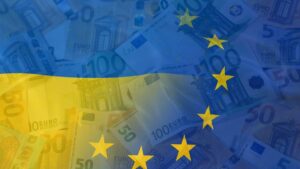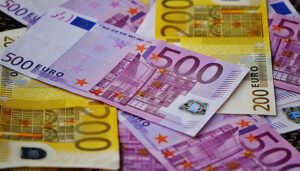
President of Ukraine Volodymyr Zelensky discussed with President of World Bank Group David Malpass an increase in the World Bank role in the stability of Ukraine’s financial sector and thanked for the provision of $350 million in financial assistance.
“Discussed with David Malpass the increasing role of the World Bank in the stability of Ukraine’s financial sector. The World Bank President noted economic stabilization, land reform and infrastructure projects in Ukraine. We are grateful for $350 million in financial support,” Zelensky wrote on Twitter on Saturday while in Munich.

The Council of the European Union approved on Friday the decision of the European Commission to provide additional macro-financial assistance worth EUR 1.2 billion to Ukraine.
“The current geopolitical tensions are having a severe economic impact on Ukraine. Member states are ready to provide EUR 1.2 billion macro-financial assistance. We decided to support the Commission’s proposal today, so that the financial help can reach Ukraine without delay,” President of the EU Council, French Minister for Economic Affairs, Finance and Recovery Bruno Le Maire said.
The decision will come into force after approval by the European Parliament, which should happen in the near future. The emergency macro-financial assistance is set to have a duration of 12 months and it would consist of two disbursements. The disbursement of the second tranche would be linked to the continuous satisfactory implementation of both an IMF programme and the policy measures agreed in the Memorandum of Understanding.
“Persistent security threats have triggered a substantial outflow of capital. Against the backdrop of the loss of access to international capital markets due to the heightened geopolitical uncertainty and its impact on the economic situation in Ukraine,” the EU Council press service said, justifying the urgency of providing additional assistance.
The EU-Ukraine Association Agreement, which entered into force on September 1, 2017, brings the Ukraine and the EU closer together. In addition to promoting deeper political ties, stronger economic links and the respect for common values, the agreement has provided a framework for pursuing an ambitious reform agenda, focused on the fight against corruption, an independent judicial system, the rule of law, and a better business climate.
Among other support instruments, between 2014 and 2021 the EU supported Ukraine through five consecutive Macro-Financial Assistance (MFA) operations that totalled EUR 5 billion of loans.
On February 1, 2022, the Commission submitted a proposal for an additional 1.2 billion macro-financial assistance to Ukraine in the form of loans to strengthen stability.
The same amount of assistance, but from France, was announced by President Emmanuel Macron during a recent visit to Kyiv. He called it “state guarantees for financing Ukrainian projects of French companies” within the agreement reached back in May.

EU macro-financial assistance in the amount of EUR 1.2 billion, in providing which France has taken an active part, will be used to stabilize the Ukrainian economy, President of Ukraine Volodymyr Zelensky has said following a meeting with French President Emmanuel Macron.
“Economic support is very important, and we really appreciate such a step of solidarity with other states, a powerful step on the part of Emmanuel, on the part of France – the allocation of EUR 1.2 billion in macro-financial assistance to Ukraine. This will really help us stabilize our economy. We are already doing well, but this is a powerful step for the economic sustainability of Ukraine,” Zelensky said at a joint press conference with Macron on Tuesday in Kyiv.

The assets of financial companies in January-September 2021 increased by 4.7% compared to the beginning of the year (UAH 182.13 billion), to UAH 190.704 billion, according to a review of the nonbank financial sector on the website of the National Bank of Ukraine (NBU) on Tuesday.
According to the report, the growth of assets in July-September 2021 amounted to 6.2% due to the growth in the volume of all types of financial services provided during the quarter, thanks to it, the volume of assets recovered to the highest level of 2019.
The NBU said that the total volume of services provided by financial companies in the third quarter grew by 21.1%, to UAH 281.077 billion, including services for trading foreign exchange valuables by 18.3%, to UAH 75.695 billion, funds transfer by 10.2%, to UAH 127.336 billion.
The volume of loans issued by financial companies in the third quarter rose by 16.6%, to UAH 33.91 billion, including loans to individuals by 5.8%, to UAH 17.18 billion, and loans to legal entities by 30%, to UAH 16.528 billion.
The number of financial companies in Ukraine in the third quarter grew by 1.3%, to 984, while their total equity capital increased 8.2%, to UAH 29.695 billion.

At the 22nd Ukraine-EU Summit, Kyiv signed three agreements with the European Commission and three agreements with the European Investment Bank (EIB) aimed at financing various projects.
In particular, an agreement to finance the EU4ResilientRegions programme for EUR 30 million was signed between the Ukrainian government and the European Commission.
According to the document, the EU4ResilientRegions programme aims at enhancing the resilience of eastern and southern Ukraine to the negative impacts of the ongoing conflict, including to hybrid threats and other destabilizing factors. The action will also address most recent destabilization factors such as the COVID-19 pandemic and its social and economic impact. In response to the conflict in eastern Ukraine and the illegal annexation of Crimea and Sevastopol, this action will aim to enhance Ukraine’s overall resilience, notably to hybrid threats.
The Civil Society Facility programme for EUR 20 million was also signed between the Ukrainian government and the European Commission. The programme focuses on social innovation and active citizenship as core principles for civic engagement and the premises for sustainable democratic societies. It aims to support the capacity of civil society organizations to engage in policy dialogue, to act as governance actors and to drive the country’s social and economic development.
In addition, the Climate package for a sustainable economy (CASE) programme for EUR 10 million was signed between the Ukrainian government and the European Commission.
This programme supports Ukraine in the implementation of measures towards a climate neutral, clean and resource-efficient economy. This includes support in areas such as circular economy and waste management, energy efficiency, emission-free urban transport as well as support to climate mitigation and adaptation.
In addition, this agreement provides for the creation of a joint resource center for climate innovation between Ukraine and the EU and the implementation of “green” measures within the framework of the National Transport Strategy until 2030.
All three documents were signed by Deputy Prime Minister of Ukraine for European and Euro-Atlantic Integration Olha Stefanishyna and Member of the European Commission for European Neighbourhood Policy and Enlargement Negotiations Olivér Várhelyi.
Three agreements with the EIB were signed.
Minister for Communities and Territories Development of Ukraine Oleksiy Chernyshov and Vice-President of the European Investment Bank Teresa Czerwińska signed an Agreement between the Government of Ukraine and the EIB on financing the Energy Efficiency of Public Buildings in Ukraine project. The loan will enable the installation of modern equipment in buildings, such as meters and energy consumption control systems, the modernization of heating, ventilation and lighting systems, and upgrades to exterior surfaces (facades, roofs, slab insulation, basement ceilings, replacement of windows and doors).
Also a EUR 30 million loan provided for by the guarantee agreement Logistic Network (Ukrposhta modernization and digitalization) was signed by Ukrainian Infrastructure Minister Vladyslav Krykliy, CEO of Ukrposhta JSC Ihor Smelyansky and Vice-President of the EIB Lilyana Pavlova.
The loan will allow Ukrposhta to start modernizing its logistics network with three new sorting hubs, 20 postal depots and IT infrastructure. The beneficiary is to return the loans within 20 years.

The draft national budget of Ukraine for 2020, prepared for second reading, provides for UAH 73.7 billion to finance road infrastructure, which is 36% more than in 2019. According to Minister of Infrastructure Vladyslav Krykliy, the budget for 2020 doubles the cost of road safety to UAH 3.17 billion, and increases by five times financing for the development of airfield complexes, to UAH 1.07 billion.
Some UAH 500 million was laid for the construction and reconstruction of bridges, UAH 116 million for ensuring the operationally safe condition of shipping locks.
In addition, the minister noted that within the framework of projects with international financial organizations, it is planned to develop urban passenger transport in Ukrainian cities (UAH 400 million) and modernize the Ukrainian railway (UAH 200 million).
“From the second half of 2020, we expect additional financing for infrastructure development projects due to excess of customs VAT and excise taxes,” the minister added.